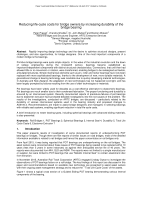Bridges

- Publication no: ABC2017-156-17
- Published: 26 April 2017
- PDF (free) Download
Rapidly improving design technology and the desire to optimise structural designs, present challenges, and also opportunities, for bridge designers. One of the most important components of a modern bridge is the bearings.
Primitive bridge bearings were quite simple objects. In the wake of the industrial revolution and the dawn of railway engineering during the nineteenth century, bearings became established as important/independent components with distinct structural characteristics. Connections, that until then had allowed little or no movement or rotation, were transformed, enabling bridges to be redesigned as flexible, articulated structures. Simple mechanical elements such as pin, roller and rocker bearings have now been replaced with more sophisticated bearings, thanks to the development of new, more durable materials. A generational change in bearing technology was inevitable due to quickly developing material technologies. In Australia and New Zealand, the adaptation of new technologies has not happened overnight, and has been largely prompted by failures resulting from the use of older technologies or materials. Pot bearings have been widely used for decades as a cost-effective alternative to elastomeric-bearings.
Pot bearings are much smaller due to their condensed fabrication. The proper functioning and durability is ensured by an internal-seal system. Recently documented reports of premature-failures of pot bearings due to elastomer extrusion have prompted detailed investigations into the root causes of the problem. The results of the investigations, conducted on ARTC bridges, are discussed – particularly related to the durability of various internal-seal systems used in the bearing industry and proposed changes to AS5100.4. Recommendations are made to assist bridge designers and managers in selecting bearings with reliable seal systems, enabling significant reduction in total life-cycle costs.
A brief introduction to newer bearing types, including spherical bearings with advanced sliding materials, is also presented.
